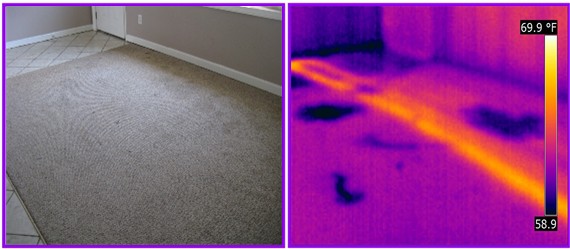Need I say more?
Nice catch these hillbilly’s out here just don’t use that type of heat I would like to be able to scan some of that. Are you sure there was not a large dog in the house. Just kidding:D
I did a draw on a house not far from David’s favorite presidential candidates mothers home that had radiant heat being installed in their driveway. No need to shovel snow in the winter.

Please don’t mention THE BITCH as it makes me sick to my stomach.
We have numerous radiant driveways here also…

Wow Linas,
I always wondered how the rich folks lived, heated driveways, and a toilet in the front yard in case they get “caught short” weeding the petunias~~ Now thats living ![]()
Regards
Gerry
David:
Is this a concrete slab installation?
Did you ever find out what’s going on with the colder spots? Cold/cool water pools? Irregular shapes would indicate that it’s not missing insulation.
This radiant heating had the supply pipes embedded in concrete. Once I saw the wet spots on IR, I walked over to the areas in question and the wet areas were apparent. I was stepping in water within the carpet. The system had to be abandoned, and that’s how I reported it.
David, I am a little confused.
Why would the infared only showing one loop, and why, if this is a leak are they so far away from the radiant tubing itself?
I have installed many radiant pipes in concrete and if damaged when pouring the concrete would show up almost immediately after the system is charged.
In my case, I always have 50 lbs of pressure when I pour, so I would know right away.
With that being the case, what would have damaged them after all this time.
Did they use the standard underfloor heat pex, or was it a different material?
I know, I ask to many questions. ha. ha.
Marcel 

Marcel,
Marcel,
I’m not a plumber so I am unable to tell you why there is only one hot loop amoungst all the others that should be getting hot. All I know is I had the boiler running for about twenty minutes, I then touched the return line above the boiler and it still felt cool. This told me that the radiant heating zone was not functioning properly (the return should have been warm or hot to the touch).
That’s when I went to my truck to get my infrared camera and once I pointed the camera at this floor, those are the images I were seeing. I walked around the carpeted area and found myself stepping in water everywhere.
You can see my footprints here…

If you installed these systems and you are familiar with them, then you should be able to tell me what is going on here.
In this IR image you can see where the pipe on the outside is a tad hotter but is puddling at this area. The other hotter piping has an opening which appears to be where the leak is…



It would seem the IR would pick up all of the radiant loops and not just one.
Actual leak would be about 80 degrees to touch.
http://www.buildinggreen.com/nav_images/header_left.gif
http://www.buildinggreen.com/nav_images/header_right.gif
Typical installation in a concrete slab.
Operating temperatures of the radiant system is usually 95-120 about 2" down in the concrete.
Temperature differential on the supply and return could be as much as 15-30 degrees.
So temperature at the return of the boiler could be like 70-80 degrees.
The only sure way to know that it is a radiant floor leak is to put a pressure test on the line and that would varify your findings that there is in fact a leak.
Just a weird picture that gets me going. ha. ha.
Some times my loggic drives me nuts. ![]()
Marcel ](“http://www.buildinggreen.com/cgi-bin/scale.cgi?width=250&src=/articles/images/1101/wirsbotubinglayout.jpg”)
Marcel,
The heated water was not returning or even attempting to get into the entire piping system in this particular room. That’s why I told my clients to abandon the system.
